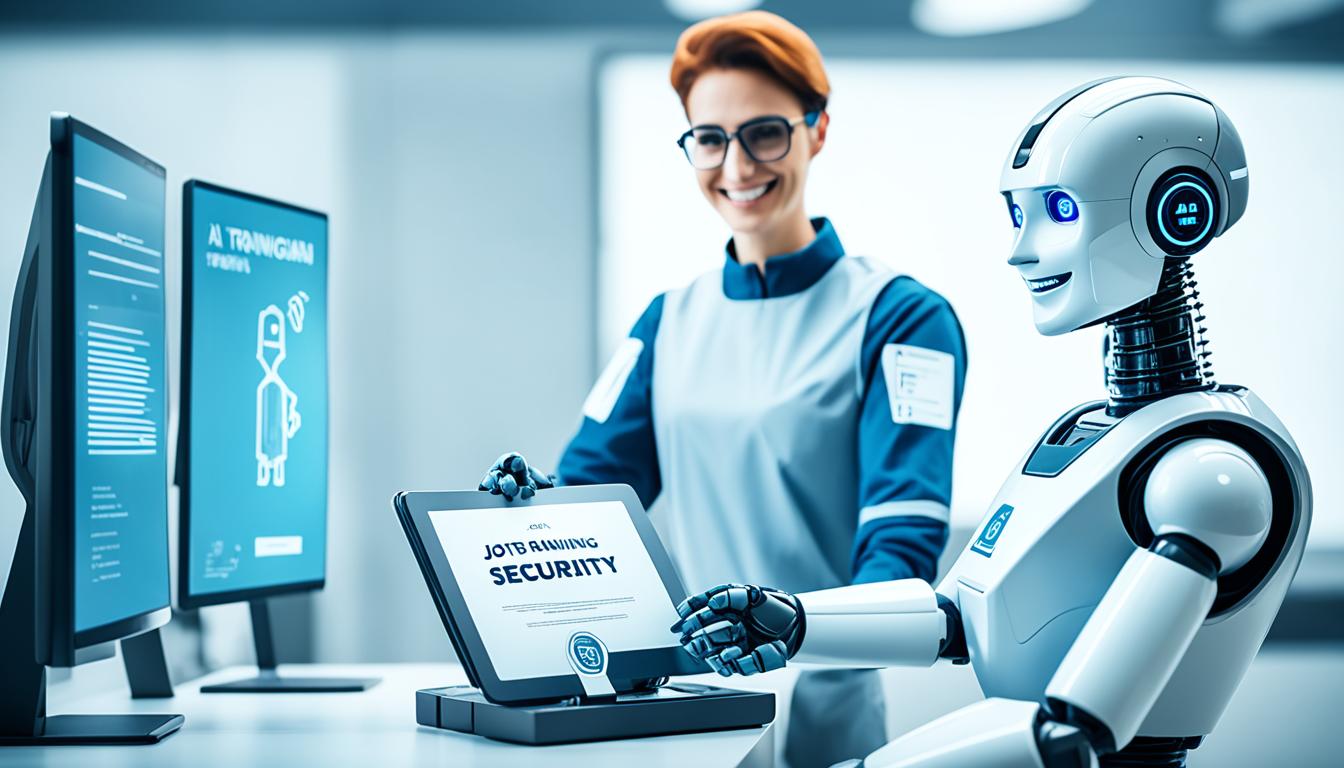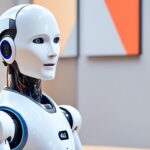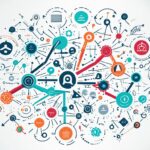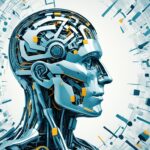The growth of artificial intelligence (AI) technology could change many industries. However, myths and misconceptions about AI are common. They can stop people and businesses from understanding its true value. In this article, we tackle the biggest myths about AI. We’ll show what’s real about its powers and boundaries.
AI is not out to steal your job
Many think AI will take human jobs away. This is not true. AI helps by doing tasks like data entry. It does not aim to replace people but to support them. This changes the type of work people do, making it more valuable.
Even though AI can do some work, it can’t do everything. People still worry about job security. Yet, AI is likely to make jobs better, not take them away. A report says by 2025, AI will create more jobs than it gets rid of.
“Artificial intelligence will not replace people, but it will replace tasks.” – Kai-Fu Lee, AI expert and CEO of Sinovation Ventures
AI is great for boring tasks, leaving humans to solve big problems. This shift lets employees focus on work that needs human touch. So, jobs feel more fulfilling and help people grow.
AI and job automation
AI makes work faster and more efficient. It does repetitive jobs quickly. This change means workers can do tougher and more strategic tasks.
AI also helps in making decisions. It analyses lots of data to give valuable advice. This helps employees make better choices and push the business forward.
Job security in the age of AI
Even if AI changes jobs, it doesn’t mean jobs will vanish. As AI takes over simple tasks, people can learn new skills. Companies should train their staff to work with AI technologies.
Staying relevant means adapting to new tech. Seeing AI as a partner helps employees improve their skills. This way, they can keep up in a changing job market.
Working with AI means a brighter future for job security. AI is an important tool that helps people and companies do better. It makes achieving success and innovation easier.
| AI | Job Automation | Job Security |
|---|---|---|
| Enhances human capabilities | Automates routine and repetitive tasks | Opportunities for upskilling and reskilling |
| Collaborative role in the workplace | Streamlines workflows and improves efficiency | Ability to adapt and evolve with technology |
| Augments jobs, not eliminates them | Handles large volumes of data and provides insights | Partnership between humans and AI |
AI can be biased, but steps can be taken to mitigate it
Many believe that AI is free from bias. Yet, it’s crucial to understand that AI algorithms can reflect human biases. These algorithms are trained on data often selected by people. Thus, they can unintentionally include existing biases. This brings up worries about AI, algorithmic, and data biases.
To make things fair and equal, we can take steps to lessen AI bias. The first step is to carefully choose and prepare the training data. It must be diverse and mirror society’s various groups. By adding many viewpoints, we can reduce biases. Also, we can design machine learning models to spot and fix biases as they happen.
Addressing AI bias is crucial to create fairer and more equitable AI systems.
When making AI systems, businesses and groups should think ethics first. Adding ethical rules to the design and building phase helps catch and reduce biases. Being open and accountable is key to making fair and unbiased AI systems.
It’s important to remember that fighting AI bias is a constant effort. As new data comes in and algorithms get updates, we must keep checking and testing to keep biases low. Aiming for fairness and inclusiveness helps create AI that’s good for everyone.
AI and machine learning are not the same thing
Many people find the ideas of artificial intelligence (AI) and machine learning confusing. AI is a broad field. It covers techniques that let machines act with human-like intelligence. Machine learning, however, is a specific part of AI. It focuses on algorithms that learn from data and make decisions.
Put simply, AI is the larger concept that includes several methods. These methods enable machines to perform tasks that need human intelligence. Machine learning is a particular method under AI. It allows machines to learn and get better from their experiences without being programmed for every task.
Machine learning algorithms work by looking at data to find patterns. They learn from these patterns. Then, they make decisions or forecasts. Because they learn from the data they’re given, these algorithms are great for jobs like recognizing photos, processing natural language, and predicting future events.
What is Deep Learning?
Deep learning is a part of machine learning. It draws inspiration from the human brain’s structure and functions. This advanced method uses layers of artificial neural networks. It pulls out complex features from data to make very accurate predictions or identifications.
Deep learning is super good at recognizing speech, spotting objects, and understanding language. It’s had huge successes in areas like health care, finance, and self-driving cars.
“Deep learning has revolutionized the field of AI by enabling machines to automatically learn and understand complex patterns and relationships in data.”
Though machine and deep learning are key parts of AI, AI is not just about these techniques. It includes a wider array of technologies and methods, such as expert systems, knowledge representation, processing natural language, and robotics.
Realizing the differences between AI, machine learning, and deep learning helps us better understand these technologies. With this understanding, we can make smarter choices about how to use them in various fields.
Key Takeaways:
- AI is a wide concept that includes ways for machines to mimic human intelligence.
- Machine learning is a part of AI focusing on algorithms that learn from data to make decisions.
- Deep learning uses many-layered neural networks and excels in making accurate predictions.
- Knowing the differences among AI, machine learning, and deep learning leads to better decisions in using these technologies.
AI is accessible and affordable for businesses of all sizes
AI isn’t just for big companies with huge budgets anymore. Now, businesses of all sizes can use AI thanks to its democratization. Cloud platforms make it easy to use AI, without needing special skills or knowledge.
Small and medium enterprises (SMEs) are using AI for things like chatbots and automating tasks.
The good things businesses get from AI include:
- They become more efficient and productive. AI automates tasks, saving time and resources.
- Businesses make better decisions. AI helps them understand lots of data quickly.
- Customers get better service. AI chatbots give personalized help, making customers happier.
- Small businesses stay competitive. With AI, they can use the latest tech to stay ahead.
Cloud platforms have been key in making AI easy and cheap to use. They offer ready-made AI tools that businesses can add to their systems easily. This means companies don’t need to spend a lot on new tech or hire AI experts.
“AI is now easy and affordable for all businesses, thanks to cloud platforms.”
“AI’s democratization means SMEs can use advanced tech without huge costs. Cloud platforms have easy-to-use AI tools. This lets businesses add AI quickly, without needing lots of money or tech know-how.”
Using AI can change a business, no matter its size. Thanks to easy and cheap access through cloud platforms, businesses can grow and innovate.
Use Cases of AI for SMEs
Many SMEs across industries have seen big wins by adding AI to their work:
| Industry | AI Application | Benefits |
|---|---|---|
| Retail | AI-powered demand forecasting | They manage stock better, have fewer out-of-stock items, and customers are happier. |
| Healthcare | AI chatbots for patient support | Patients get 24/7 help, shorter wait times, and feel more involved in their care. |
| Manufacturing | AI-powered predictive maintenance | Machines work better for longer, with less downtime and saving money. |
| Marketing | AI-driven customer segmentation | Ads reach the right people, bringing in more customers and better returns on investment. |
The image shown highlights how AI is open for all businesses. It’s about bringing SMEs into the AI world, removing hurdles.
AI is not capable of human-like thinking
In science fiction, AI often seems to think and act like humans. But in reality, AI works through algorithms and data analysis. It doesn’t have the same mental abilities that we do. AI is good at finding patterns and making choices based on data. Yet, it struggles in areas that need understanding of emotions or context. We must understand what AI can and can’t do.
AI has some impressive skills, but it’s not as complex as human intelligence. Through algorithms, AI can look through lots of data and see patterns we might miss. This skill is very valuable in fields like healthcare, finance, and marketing. AI systems can quickly work through lots of information and make decisions based on data.
But, AI can’t fully understand human emotions or the context of situations. It can recognize feelings through sentiment analysis, to a point. Yet, AI doesn’t grasp deep emotional intelligence like we do. It struggles with complex feelings, sarcasm, irony, or hidden hints that humans pick up easily.
“AI’s functionality is based on algorithmic processing and data analysis, and it does not possess the same cognitive abilities as humans.”
AI also lacks the contextual understanding that comes naturally to humans. It cannot interpret situations with personal experience, cultural background, or social hints like we do. AI uses data patterns and statistical chances to make predictions. It relies on the data it’s trained on and can’t think creatively or make intuitive leaps.
We should value AI’s abilities but also see its limits. AI is a powerful assistant that can help with decision-making and process streamlining. However, it is not a substitute for human intelligence or emotional depth.
AI Capabilities:
- Pattern recognition and analysis
- Data-driven decision-making
- Efficient processing of large volumes of information
Limitations of AI:
- Lack of emotional intelligence
- Inability to understand contextual cues
- Dependence on existing data and algorithms
By knowing AI’s strengths and weaknesses, we can use it effectively in many areas. AI can change industries, boost productivity, and enhance decision-making. However, it’s important to have realistic views of AI. We must remember that it can’t think or feel like humans do.
Conclusion
In conclusion, busting AI myths is vital for knowing its real power and limits. Clearing up these myths helps to reduce fear and doubt. It lets us make wise choices, aiming for a fair and broad-ranging artificial intelligence-powered future.
First off, AI isn’t here to take away jobs. It works as a helper, automating simple tasks. This lets people focus on jobs that matter more. Many leaders in business have come to accept this change.
Second, though AI can show bias, there are ways to lessen it. AI learns from data, which might reflect human prejudices. By picking and refining the data well, and using tools to identify and fix biases, we can build fairer AI systems.
Third, AI is reachable and affordable for all kinds of businesses. The spread of AI has made it simpler for companies to use its benefits. Thanks to cloud services, AI tools are easy to use without needing a lot of tech knowledge. This means even smaller businesses can bring AI into their daily work.
Finally, it’s key to know that AI can’t think like humans. It’s good at spotting patterns and making choices based on data, but it can’t understand emotions or context as we do. We must keep our expectations of AI real to use it well.
By accepting what’s true about AI and ignoring the myths, we can fully use this tech for society’s gain. It points us toward a future where AI helps us advance, innovate, and live better.
FAQ
Is AI designed to steal jobs from humans?
No, AI does not aim to take over human jobs. Instead, it helps to boost their skills. It takes over simple, repetitive tasks. This lets humans do more complex and creative work.
Can AI be biased?
Yes, AI can show bias because it learns from human-made data. Biases can sneak into the algorithms this way. By selecting training data carefully and fixing biases, we can reduce this problem.
What is the difference between AI and machine learning?
AI is a wide field that covers techniques mimicking human thought. Machine learning, a part of AI, learns from data to make decisions. Machine learning is critical to AI but is just one part of it.
Is AI only accessible to large organizations with extensive budgets?
Not anymore. AI technology is now within reach for all businesses, big or small. Cloud platforms have made AI tools easy to use without deep tech knowledge. Even small companies are using AI successfully.
Can AI think like a human?
No, AI can’t think as humans do. It works based on data processing, good at spotting patterns and making data-based choices. But, AI can’t match human emotional and contextual understanding.


















